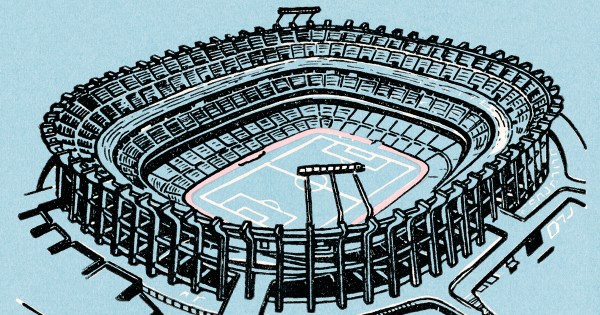
Perhaps none of this would matter to an able-bodied, hardcore sports fan, but this type of fan is not who most new sports brands are trying to engage. The sweet mix of spectacle and sport, when done right, is the meeting point between a hardcore fan and their less enthused partner. It’s how I get my best friend—entirely uninterested in cricket—to spend a Saturday with me. It’s how the sport is shared beyond the primary audience and transcends generations, becoming a “family” sport. It’s key for the sport to live on.
The spaces that knock this out of the park often share a common problem—crowd control. Anticipation of large (sometimes boisterous) crowds inspires intuitive design, because it’s where it’s needed most.
Anfield—home to Liverpool FC, bathed in red and white—is an excellent example of using color to root a space in the brand. I was there soon after The Hundred and, in stark contrast, found that the scoreboard, the usher uniforms, and the signage used the color palette to their advantage instead of being a distraction. The website showed the number of accessible seats in each section, and there was an additional black-and-white scoreboard, in plain text and legible from a distance. The experience was seamless, and that’s the unfortunate goal—to disappear in the experience you aim to enhance.
Similarly, the Indian Premier League attracts massive audiences, both at the matches and on television. It needs to account for every possible kind of audience member—therefore, it does. The TV graphics of the IPL break down the rules of cricket in creative and effective ways; it’s how the youngest family members grow up to be avid fans. The tournament was conceptualized with the vision to bring new generations into cricket, and by placing the audience experience at the center of its brand, it has created a modern legacy.
Conversely, the fear of sacrificing legacy is a major obstacle in redesigning heritage brands to be accessible. Wimbledon, however, expertly demonstrates modernity is not a trade-off for tradition. The iconic green-and-purple palette is instantly recognizable, yet never overwhelming, rooting the wayfinding and signage in tradition while maintaining thoughtful, minimalist design. The tournament remains forward-thinking as it leverages cutting-edge technology like IBM Watson for AI-powered highlights and real-time insights. The use of smart technology is beautifully wrapped in its legacy brand to enhance the spectator experience without overshadowing the sport or lasting elegance of the All England Club.
As the Super Bowl fades into memory, the focus now shifts to other major sporting events, like Formula 1 and Six Nations Rugby, where good design will once again be put to the test. With F1’s global appeal continuing to grow, its ability to balance cutting-edge spectacle with clear, functional race graphics and fan-friendly experiences will be key to maintaining its momentum. Similarly, the Six Nations—steeped in tradition but eager to attract new audiences—has an opportunity to show how intuitive design can enhance both the in-stadium experience and broadcast clarity. These events serve as a reminder that while spectacle draws attention, it’s thoughtful, accessible design that ensures fans, both new and old, stay engaged and connected to the heart of the sport.






